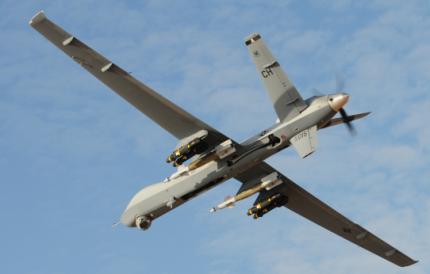In drone wars, dogfights won't be in the air but in the spectrum
All unmanned craft use an RF link, with makes them vulnerable, says the chief of the Army’s Electronic Warfare Division. DOD is looking for an electromagnetic advantage.

Like other senior officers in kindred offices in the Defense Department, Col. Jim Ekvall, who heads up the Army’s Electronic Warfare Division, is concerned with how to answer the looming threat of enemy UAVs to U.S. and allied unmanned fleets.
The timing is ripe. It’s clear America’s nemeses are growing technologically adept—case in point: Iran’s apparent “re-direct” or forcing down of a U.S. RQ-170 Sentinel in 2011. Moreover, the world trade in robotic aircraft and technology is gigantic and barely controlled. So prepping for anti-drone combat—“drone wars” as some call the prospect—is important.
The overarching construct is called Counter-Unmanned Aerial Systems, or C-UAS. One EW niche witnessing a surge is Ekvall’s special bailiwick: electromagnetic spectrum operations (EMSO).
“I’m primarily interested,” he said in a wide-ranging interview with Defense Systems, “in electronic warfare only; and specifically, providing the ability for the ground tactical commander to gain and maintain an advantage in the electromagnetic spectrum.” His goal is to thwart any system that adversaries use to communicate, or to pass data radio-to-radio, or machine-to-machine using the RF spectrum as its transport layer.
“Or,” he added, “one person using a machine that can do data-input, maybe, that turns into a radio signal and goes to another machine that does radio reception—I’m preventing that from occurring.”
At root, Ekvall’s electromagnetic tools can prevent adversaries from communicating via the electromagnetic spectrum (EMS).

UAV's use of the spectrum makes them vulnerable to attack, Ekvall says.
“All UAVs are dependent on the EMS, one way or another. And they all use an RF link either for terminal guidance or for navigation or targeting or for passing information,” he said. Thus, any link to the aircraft is “susceptible to attack inside of the EMS.”
The Army in 2009 developed CAESAR (Communications Electronic Attack Surveillance and Reconnaissance), a high-technology “jammer pod” and successfully deployed it to combat theaters on manned C-12 airplanes. It proved effecting in supporting ground troops in Afghanistan.
That application, though, was never seen as a long-term solution for airborne electronic attack. “We’ve always believed that we’d get better EW capability out of an unmanned platform,” Ekvall said.
Later, cooperating with the Naval Surface Weapons Center in Indiana, Raytheon Corp., and General Atomics, the identical capability was migrated for testing aboard the Gray Eagle, a proven UAV platform. In this iteration it’s called NERO, for Networked Electronic Warfare Remotely Operated.
In July, the system was tested at Utah’s Dugway Proving Ground, the airborne Gray Eagle’s jammer pod running for 20 hours at full power – and importantly, without interference with the UAV. Results were satisfactory but not conclusive, the Army said.
The pods, Ekvall pointed out, are “a counter-communications and a counter-C2 [command and control] capability,” not now related to any counter-UAS kinetic (shoot-down) targeting or other electronic solutions. They’re solely for “attacking enemy drones electronically through the RF spectrum.”
The Electronic attack jammers are obviously an active tool. The reactive side—safeguarding our own unmanned aircraft from foes’ UAVs—is the purview of the Program Manager for Unmanned Aerial vehicles. That office supplies the “requisite precautions to protect [them] from enemy use of the spectrum,” Ekvall said.
Ekvall has no illusions about foes’ rising core competencies.
“Anybody who has any warfighting sense at all understands what freedom of maneuver in the spectrum means; and the importance of their ability to deny their adversary the same,” he said. “To be successful in all the warfighting domains, you must gain and maintain advantage in the spectrum. The United States isn’t alone in understanding that.”
Asked about inter-service jointness and systems interoperability, he said, “Certainly every service has unique requirements, and so what probably drives most cooperation is can we integrate on the battlefield without causing undue and unintended consequence—so we’re interoperable and compatible.”
That doesn’t necessarily mean all branches or units need the same system. But because of the varying missions, “I would also say that when we do have similar or identical requirements, certainly the intent is to find common materials solutions.” Getting along is also bolstered by the “cross-cutting capability,” sharing capabilities across branches, that’s called for in the Pentagon’s updated EW plan, announced in April.
The electronic warfare specialist would not stipulate which of the witches’ brew of threats was the most worrisome. But regarding kinetic, directed-energy, electromagnetic pulse and cyberattacks, he said, “All those things are threats.” Nor would Ekvall name likely adversaries. But he questioned, despite the thousands of drones estimated to have flooded the world, whether enemies who’ve procured them can use them.
He said the greatest challenge was “being able to field systems of any kind that are ahead of the threat” meaning avoiding “getting it into the field it, only to learn it’s obsolete.”
In any case, concluded Ekvall, a two-tour Iraq veteran, “Providing a commander on the ground with freedom-of-maneuver in the EMS is an integral part of how we conduct warfighting today and how we’ll continue to conduct it in the future.”
NEXT STORY: Air Force orders 3 more Global Hawk UAVs

